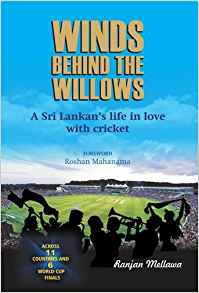Winds Behind The Willows
Martin Chandler |Published: 2017
Pages: 409
Author: Mellawa, Ranjan
Publisher: Private
Rating: 3 stars

Books about Sri Lankan cricket are rare, and any addition to the small number there are is to be welcomed. It is remarkable, for example, that no proper history of the game has been written for a country where cricket has been played since at least 1805, when a match at a British garrison is recorded as having taken place. Contrast that with New Zealand and South Africa, two countries where the game is not recorded until after that date, but both of which are well served by histories.
A few Sri Lankan players have written autobiographies, Roshan Mahanama and Aravinda De Silva being two who spring to mind, and a book about Tillakaratne Dilshan appeared only last year. The market for cricket books and, more importantly the mind set of potential buyers of them is, I appreciate, very different in Sri Lanka to England. That much conceded it never fails to amaze me how publishers in England not infrequently choose to release biographies of, and autobiographies from, cricketers who do not even represent their country once. Despite that no publishing house whether here or in Sri Lanka has yet considered it worthwhile to publish a book about the likes of Muttiah Muralitharan, Kumar Sangakkara and Mahela Jayawardene, all giants of the game on any measure.
I understand why there are no tour books about Sri Lankan Test matches, that particular genre having started to fall out of favour at around the time Test status was awarded, almost forty years ago now. But why there should be so few general books is much more surprising. There are just a few, and Michael Roberts in particular is to be congratulated for the writings on Sri Lankan cricket he has written and published.
Which brings me to Ranjan Mellawa. I am confident he won’t mind me describing him as a cricket tragic, an expression we tend to bandy about on cricketweb without too much thought. Mellawa reminds me however that cricket tragic syndrome has a spectrum. At one end are those like this reviewer, who spend much of our time in the past and amongst dusty tomes, and at the other there are those who live for the moment, and watching the current players, whether at the ground on television or both, and for whom our game’s great history is just a backdrop rather than the main event.
Mellawa, a career banker and serial follower of the national team, perhaps sits rather more towards the modern end, but by dint of having witnessed the whole of Sri Lanka’s history at the game’s top table he is clearly comfortable at my end of the spectrum as well. He has also, and understandably so given Sri Lanka’s pre-eminence, embraced the game’s shorter formats to a much greater extent than I have, but the past is not lost on him. The best part of half a century on one of my favourite Sri Lankan cricket stories is from the first, 1975, World Cup and the then Associate Sri Lankans refusing to lie down meekly against Australia in the wake of a famous assault by Jeff Thomson. My favourite paragraphs of Winds Behind The Willows are Mellawa’s take on that, although the postscript about a Police Officer talking about arresting Thommo is surely apocryphal?
In part the book is historical, and could properly be described as an incidental history of the sport in Sri Lanka. It also has autobiographical elements. Mellawa doesn’t overplay his hand on that one, but it is good to know a little about the man behind what is essentially the story of the cricket that Mellawa has watched over his lifetime. The fact that he has watched from an excellent vantage point and has had extensive access over that period to all of the great and the good of the Sri Lankan game raises the quality of his narrative well above the normal uneven quality of this sort of account.
For supporters of Sri Lankan cricket it is probably fair to describe Winds Behind The Willows as indispensable in the form it is presented. For those of us better described as neutrals it does have a tendency to drag a little at times and, had one been available, an uncompromising editor might have led to the finished product being rather more polished and better able to hold the attention of tragics who are not quite at the same point on the spectrum as Mellawa, but that is not a major criticism. Some would say it is better to have the chance to skim read a page or two rather than not have the content at all, and whilst the quality of the writing is steady rather than spectacular the book is an easy read.
A few words need to be said about the production of the book which, for a self-published effort, has been done very well indeed. It is a robust hardback which I would like to say originated in Sri Lanka, but I note was actually produced in the UK. In any event it is eminently preferable to the on demand paperbacks that increasingly appear and which, however good the content may be, create a disappointing impression. The book also contains an interesting selection of photographs and, importantly given its size and breadth of subject matter, it has an excellent index.






Leave a comment